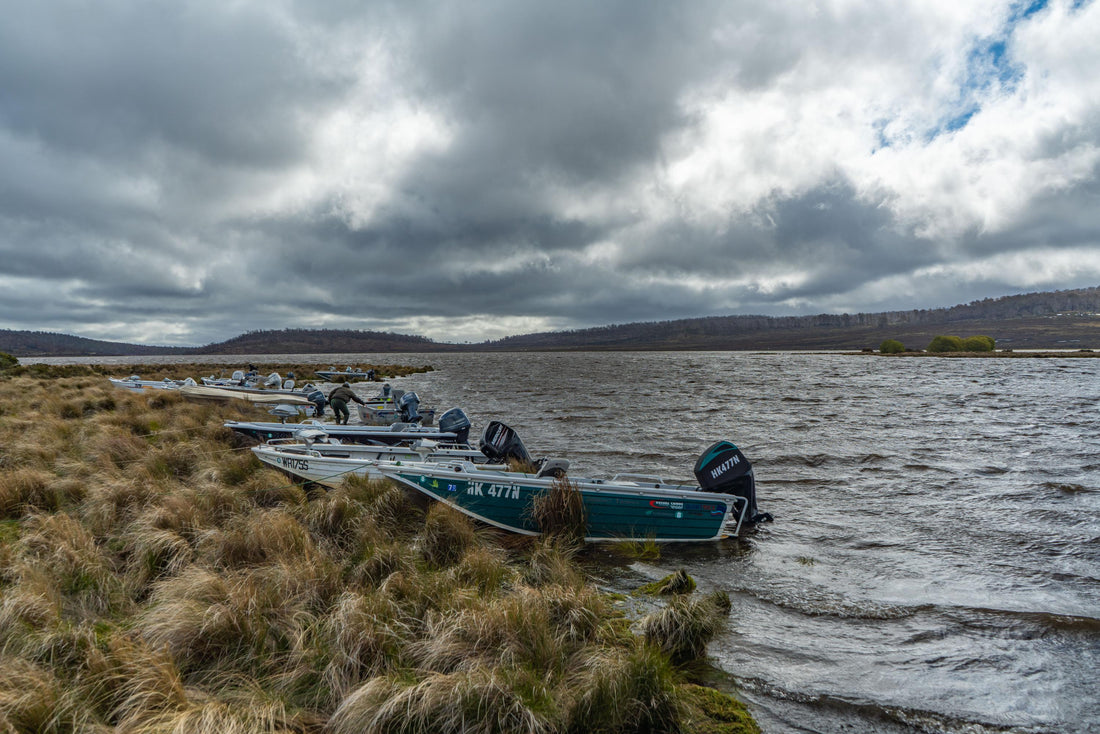
World Fly Fishing Championship 2019 in Tasmania: Session 3 on Little Pine Lagoon
Share
Of the venues during this year’s (last year now I suppose) World Fly Fishing Championships, Little Pine Lagoon is the only water that I had previously fished. It was a venue for the Oceania Fly Fishing Championships, which I fished in back in 2007. However, during that tournament they were experiencing the worst heat wave and drought on record and little pine was a warm placid puddle when I fished it. That certainly wasn’t the case during this championship.

Looking up the lake where the boats were parked at the beginning of the session. The wind, waves, and color of the water get progressively worse throughout the session.
Little Pine is one of the more famous stillwaters for fly fisherman in Tasmania. It is a nice comfortable size to feel like you can cover in a boat and become familiar with. It is also very shallow with an average depth of three to four feet deep. This makes it a productive place with lots of weed growth and insect life for a large stock of wild brown trout to feed on. However, it is also completely exposed on the central plateau and has no shelter from the wind when it decides to blow. The wind became THE story of Little Pine during the championships for a reason.
When we arrived at Little Pine the cold gale instantly smacked us as we exited the bus. Three boats had sunk on the shore from overnight waves so the organizers were hurrying to see if bilge pumps and bailing could get them ready to fish in. They ended up having to use at least one or two backup boats.
I drew Cory Scott of New Zealand as my boat partner for the session. He drew control of the boat first and decided to go to the far side of the lake first in an area the locals call the “untouchables” after the difficult tailing trout that can be found there early in the morning.
I started fishing a type 3 line with bugger/leech style flies including a flashy gold fly up top, a black one with an orange bead in the middle, and an olive one with an orange bead on the point. Given the hard hits which my teammates had received at Little Pine and the complete coffee color of the water, I sized up my tippet to 1x for this session. This also helped reduce tangles while casting three flies in 30-50 mile an hour wind. Given the wind, I made shorter casts than usual (50-60 feet) and focused on controlled turnover and contact early in the retrieve.
We started our first drift in shallow with the wind blowing us quartering out into the lake. Once we drifted out a 100 yards or so we motored back to the bank and started again forming a diagonal grid with our drift lanes. I landed my first fish about 10 minutes into the session. It was a beautifully built 47 cm male with a nice kype and a light golden color on its flank. It’s always nice to land a fish early as it helps you settle down and fish confidently.
We stayed in this same area for another half an hour, but the wind became progressively worse and the water turned from a light brown to full on espresso color as the waves churned up the bottom in the shallow water. We decided to try to get a bit of a break in the wind by heading to the hill near the dam. The hill created a lee in the wind for a few hundred yards that made the fishing much easier. The only problem was that lots of other boats had the same idea and began to pile into the area. We watched one fish landed in another boat during our first drift, but the area wasn’t producing many fish which called for a move.

The day prior, the roadside shore had produced quite a few fish for several boats. In our session, three other boats were already drifting from the dam out into the lake. They repeated the drift once they got far enough into the lake that the waves and wind became untenable. The dam didn’t provide the same lee from the wind as the hill next to it but there was a narrow band of discernibly clearer water that continued down the shore for about a ¼ mile. We tried to drift in this band of water while still maintaining proper distance from the other boats.
Cory and I both had a few hits from smaller fish here. I also hooked one early during a retrieve, but it was small and came off when it started an alligator roll. After several drifts we knew we needed a different plan. The fish we wanted weren’t coming to the boat, there were too many boats in the area, and the water was getting progressively more turbid even along the roadside as the wind increased.
The roadside shore and the inlet were the two areas which had clear water on the prior days. Our controller told us that the wind was the worst of the week to that point during our session so clear water became an even more important strategy. I was in control by this point, so I opted to head to the inlet as it was the only other known quantity for clear water.
It was a long motor to the inlet with the 10 mph rule the organizers had instituted on the lake. As we approached, we could see much clearer water. There was a point of land that shunted the worst of the waves out of the inlet bay and kept the conditions better inside. There were already four of the 12 boats inside the small bay, so we tucked barely inside the point for our first drift to avoid affecting their drifts. On our first drift, Cory got on the board with a nice fish.
After that we tried to work our way incrementally deeper into the bay toward the inlet with successive drifts. This wasn’t easy since we were doing a dance around the drifts of all the other boats. However, Pat Weiss had caught several fish right at the top of the bay, where the river came in, the day prior. We hadn’t seen any boats go that deep into the bay, so I wanted to get there to see if there were fresh fish to be caught.
Eventually we reached the inlet. There was a clear deeper channel on both sides where the river cut out into the lake. There was also an island of tussock grass along the edge of the channel a few yards out into the lake. Looking at the area, the most obvious places for fish to be caught were along the edges of the channel and tucked tight along the bank of the tussock. We only had about 15 minutes left in the session when we got to the inlet. I knew we only had one chance at a drift here because we would spook any trout in the area with the boat and wouldn’t have time to rest them before the session ended.
As we drifted over the channel, Cory had a fish miss his flies and then flash on them as they reached the boat, which made it obvious there were fish here to be caught. Unfortunately, my line had tangled in the bottom of the boat. I frantically worked to get the line untangled and worked it free with about 70 feet of drift left before we hit the tussock island.
I made four successive casts dropping my point fly less than a foot from the edge of the tussocks. I figured my shot was over at this point since my fly hadn’t been eaten already and your first shot is always your best shot. However, on my last cast, with only 30 feet of drift left, a fish took my point fly. I fought the fish hard and landed it as our boat was about to run aground on the island. It was similar in size to my first fish, but this time showed the rounded lower jaw and protruding belly of a female.
There were only a few minutes left in the session at this point. We ended up finishing one more drift slightly out into the inlet bay again but there had been boats all over the area recently and we didn’t find any other willing takers. While my session ended on a positive note, it turned sour quickly when my fly line got caught in the propeller as we were leaving and torn to bits. Speaking of that line, I still need to replace it so it’s good I’ve reminded myself by writing this.
I knew my two fish in the session would be ok but not great. I finished 7th in the session losing to Tomas Adam (Czech Republic) and Garth Nieuwenhuis (South Africa) who both had had two fish but more cm of length. David Arcay (Spain) and Sebastien Vidal (France) both had three fish and Tom Jarman of Australia won the session with seven fish.
Speaking of Australia, Little Pine was the venue the home team dominated through most of the championship more than any other. Talking to several of their members after the championship, they all said that fishing “the drop” was the most important thing on Little Pine. When they made a cast, they made two quick strips to get the flies tight for strike detection and add some initial action. Then they used a hand twist retrieve or steady strip to let the flies sink on a tight line. If they didn’t catch a fish within 10-15 seconds, they quickly retrieved their flies and started another cast focusing on “the drop” again. The fish were attracted to the flies hitting the water, but they ate them better as they were sinking without animation. Other competitors didn’t pick up on the importance on the drop during the retrieve because they would usually see the Australian angler in their session retrieving their flies back quickly but wouldn’t see the first critical 20 seconds of the retrieve where their flies were largely motionless.
Session three was the worst session for our team during the championship. In our sessions, I finished 7th, Russ Miller finished 8th, Josh Graffam finished 10th, Lance Egan finished 17th, and Pat Weiss finished 19th. This session dropped us back to 10th place overall as a team and dug the hole that we weren’t able to fully climb out of in the last two sessions.
